lights YAMAHA TDM 900 2003 Owners Manual
[x] Cancel search | Manufacturer: YAMAHA, Model Year: 2003, Model line: TDM 900, Model: YAMAHA TDM 900 2003Pages: 110, PDF Size: 7.38 MB
Page 14 of 110

INSTRUMENT AND CONTROL FUNCTIONS
Main switch/steering lock ...................................................................3-1
Indicator and warning lights ...............................................................3-2
Speedometer unit ..............................................................................3-4
Tachometer unit .................................................................................3-5
Coolant temperature gauge ...............................................................3-6
Anti-theft alarm (optional) ..................................................................3-7
Handlebar switches ...........................................................................3-7
Clutch lever ........................................................................................3-9
Shift pedal ..........................................................................................3-9
Brake lever ........................................................................................3-9
Brake pedal .....................................................................................3-10
Fuel tank cap ...................................................................................3-10
Fuel ..................................................................................................3-11
Fuel tank breather hose ...................................................................3-12
Catalytic converter ...........................................................................3-12
Seat .................................................................................................3-13
Storage compartment ......................................................................3-14
Adjusting the front fork .....................................................................3-14
Adjusting the shock absorber assembly ..........................................3-16
Luggage strap holders .....................................................................3-18
Sidestand .........................................................................................3-18
Ignition circuit cut-off system ...........................................................3-19
3
5PS-28199-E1 8/29/02 9:16 AM Page 13
Page 16 of 110
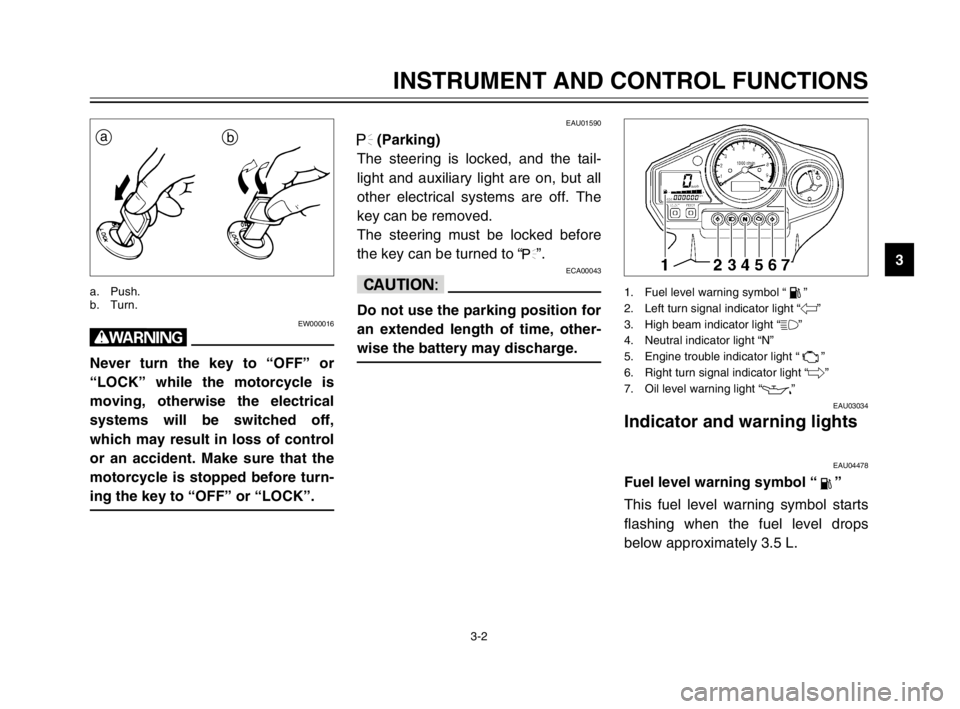
3-2
INSTRUMENT AND CONTROL FUNCTIONS
3
EW000016
w
Never turn the key to “OFF” or
“LOCK” while the motorcycle is
moving, otherwise the electrical
systems will be switched off,
which may result in loss of control
or an accident. Make sure that the
motorcycle is stopped before turn-
ing the key to “OFF” or “LOCK”.
ab
a. Push.
b. Turn.
EAU03034
Indicator and warning lights
Indicator and warning lightsEAU04478
Fuel level warning symbol “”Fuel level warning symbolThis fuel level warning symbol starts
flashing when the fuel level drops
below approximately 3.5 L.
1. Fuel level warning symbol “ ”
2. Left turn signal indicator light “
4”
3. High beam indicator light “&”
4. Neutral indicator light “N”
5. Engine trouble indicator light “ ”
6. Right turn signal indicator light “6”
7. Oil level warning light “
7”
EAU01590
.(Parking)
The steering is locked, and the tail-
light and auxiliary light are on, but all
other electrical systems are off. The
key can be removed.
The steering must be locked before
the key can be turned to “
.”.ECA00043
cC
Do not use the parking position for
an extended length of time, other-
wise the battery may discharge.
5PS-28199-E1 8/29/02 9:16 AM Page 15
Page 17 of 110
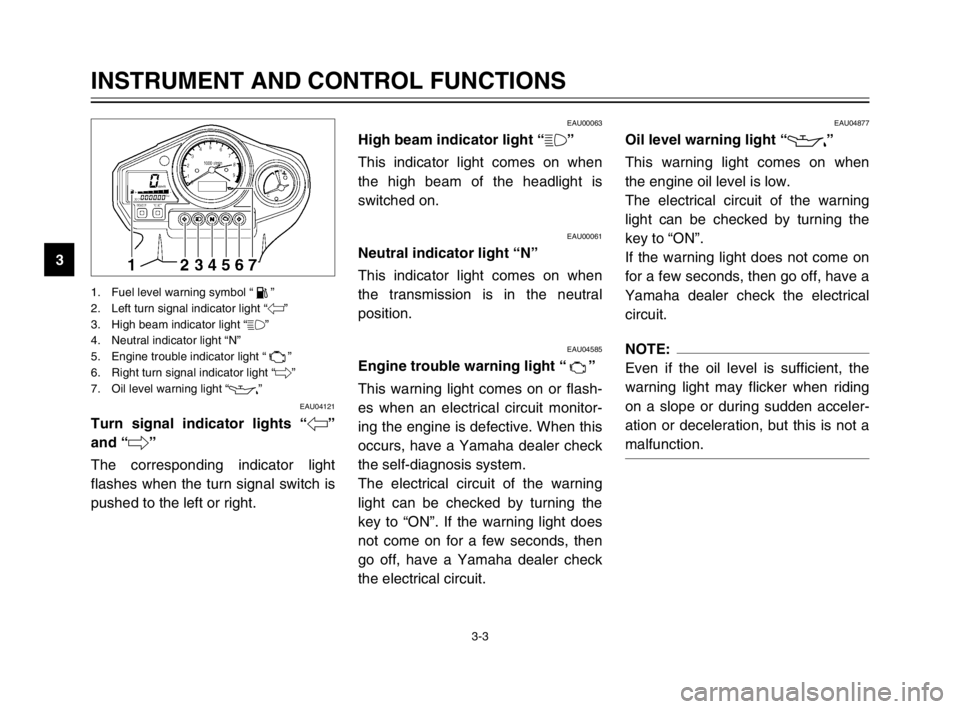
3-3
INSTRUMENT AND CONTROL FUNCTIONS
3
EAU04877
Oil level warning light “7”Oil level warning lightThis warning light comes on when
the engine oil level is low.
The electrical circuit of the warning
light can be checked by turning the
key to “ON”.
If the warning light does not come on
for a few seconds, then go off, have a
Yamaha dealer check the electrical
circuit.
NOTE:
Even if the oil level is sufficient, the
warning light may flicker when riding
on a slope or during sudden acceler-
ation or deceleration, but this is not a
malfunction.
1. Fuel level warning symbol “ ”
2. Left turn signal indicator light “4”
3. High beam indicator light “&”
4. Neutral indicator light “N”
5. Engine trouble indicator light “ ”
6. Right turn signal indicator light “6”
7. Oil level warning light “
7”
EAU04121
Turn signal indicator lights “4”
and “6”
Turn signal indicator lightsThe corresponding indicator light
flashes when the turn signal switch is
pushed to the left or right.
EAU00063
High beam indicator light “&”High beam indicator lightThis indicator light comes on when
the high beam of the headlight is
switched on.
EAU00061
Neutral indicator light “N”Neutral indicator lightThis indicator light comes on when
the transmission is in the neutral
position.
EAU04585
Engine trouble warning light “”Engine trouble warning lightThis warning light comes on or flash-
es when an electrical circuit monitor-
ing the engine is defective. When this
occurs, have a Yamaha dealer check
the self-diagnosis system.
The electrical circuit of the warning
light can be checked by turning the
key to “ON”. If the warning light does
not come on for a few seconds, then
go off, have a Yamaha dealer check
the electrical circuit.
5PS-28199-E1 8/29/02 9:16 AM Page 16
Page 22 of 110
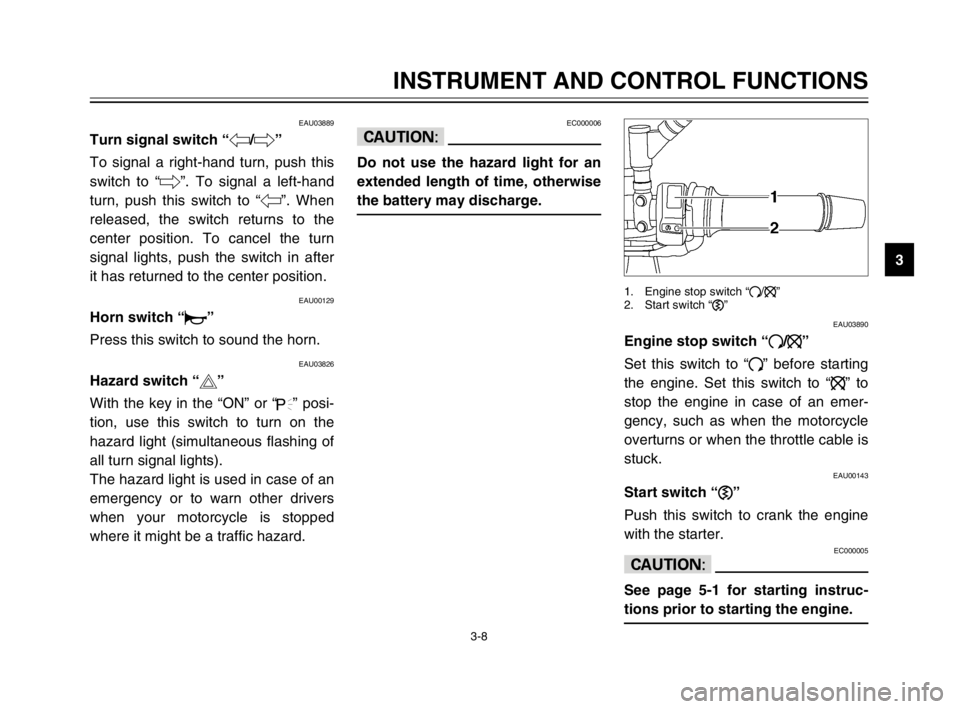
3-8
INSTRUMENT AND CONTROL FUNCTIONS
3
EAU03889
Turn signal switch “4/6”Turn signal switchTo signal a right-hand turn, push this
switch to “6”. To signal a left-hand
turn, push this switch to “4”. When
released, the switch returns to the
center position. To cancel the turn
signal lights, push the switch in after
it has returned to the center position.
EAU00129
Horn switch “*”Horn switchPress this switch to sound the horn.
EAU03826
Hazard switch “0”Hazard switchWith the key in the “ON” or “.” posi-
tion, use this switch to turn on the
hazard light (simultaneous flashing of
all turn signal lights).
The hazard light is used in case of an
emergency or to warn other drivers
when your motorcycle is stopped
where it might be a traffic hazard.
EC000006
cC
Do not use the hazard light for an
extended length of time, otherwise
the battery may discharge.
EAU03890
Engine stop switch “#/$”Engine stop switchSet this switch to “#” before starting
the engine. Set this switch to “$” to
stop the engine in case of an emer-
gency, such as when the motorcycle
overturns or when the throttle cable is
stuck.
EAU00143
Start switch “,”Start switchPush this switch to crank the engine
with the starter.
EC000005
cC
See page 5-1 for starting instruc-
tions prior to starting the engine.
1. Engine stop switch “#/$”
2. Start switch “,”
5PS-28199-E1 8/29/02 9:16 AM Page 21
Page 38 of 110

4-2
PRE-OPERATION CHECKS
4
Throttle grip•Make sure that operation is smooth.
•Check cable free play.
•If necessary, have Yamaha dealer adjust cable free play and lubricate cable and
grip housing.6-18, 6-29
Control cables•Make sure that operation is smooth.
•Lubricate if necessary.6-29
Drive chain•Check chain slack.
•Adjust if necessary.
•Check chain condition.
•Lubricate if necessary.6-27–6-29
Wheels and tires•Check for damage.
•Check tire condition and tread depth.
•Check air pressure.
•Correct if necessary.6-18–6-22
Brake and shift pedals•Make sure that operation is smooth.
•Lubricate pedal pivoting points if necessary.6-30
Brake and clutch levers•Make sure that operation is smooth.
•Lubricate lever pivoting points if necessary.6-30
Sidestand•Make sure that operation is smooth.
•Lubricate pivot if necessary.6-30
Chassis fasteners•Make sure that all nuts, bolts and screws are properly tightened.
•Tighten if necessary.—
Instruments, lights, signals
and switches•Check operation.
•Correct if necessary.3-2–3-3, 3-7–3-8, 6-35–6-38
Sidestand switch•Check operation of ignition circuit cut-off system.
•If system is defective, have Yamaha dealer check vehicle.3-18–3-20 ITEM CHECKS PAGE
5PS-28199-E1 8/29/02 9:16 AM Page 37
Page 43 of 110
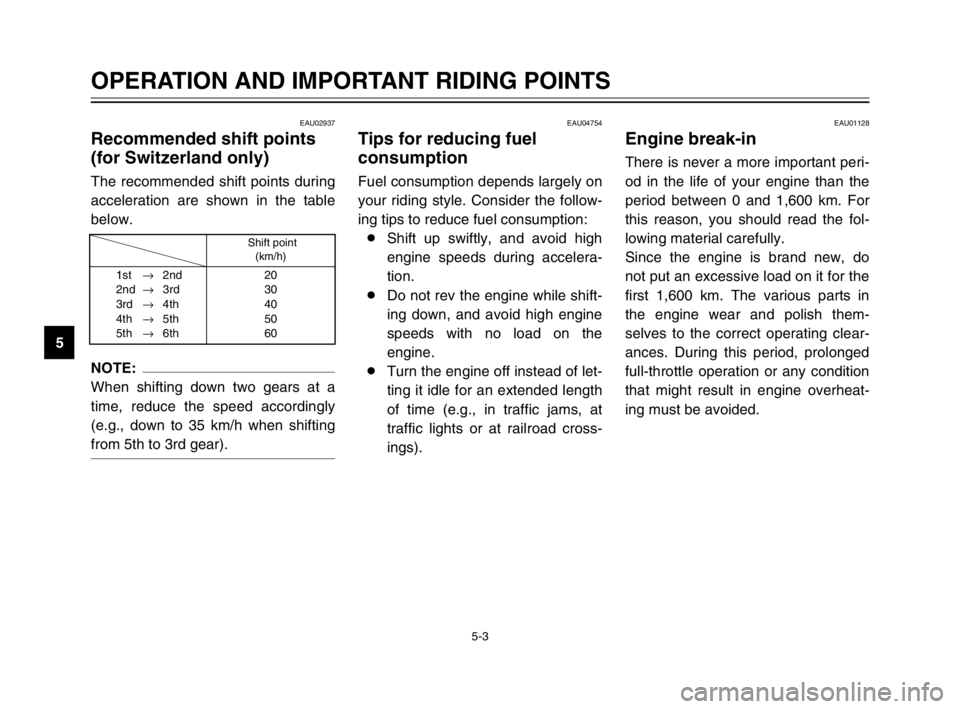
5-3
OPERATION AND IMPORTANT RIDING POINTS
5
EAU02937
Recommended shift points
(for Switzerland only)
Shift points (for Switzerland only)The recommended shift points during
acceleration are shown in the table
below.
NOTE:
When shifting down two gears at a
time, reduce the speed accordingly
(e.g., down to 35 km/h when shifting
from 5th to 3rd gear).
EAU04754
Tips for reducing fuel
consumption
Fuel consumption, tips for reducingFuel consumption depends largely on
your riding style. Consider the follow-
ing tips to reduce fuel consumption:
8Shift up swiftly, and avoid high
engine speeds during accelera-
tion.
8Do not rev the engine while shift-
ing down, and avoid high engine
speeds with no load on the
engine.
8Turn the engine off instead of let-
ting it idle for an extended length
of time (e.g., in traffic jams, at
traffic lights or at railroad cross-
ings).
EAU01128
Engine break-inEngine break-inThere is never a more important peri-
od in the life of your engine than the
period between 0 and 1,600 km. For
this reason, you should read the fol-
lowing material carefully.
Since the engine is brand new, do
not put an excessive load on it for the
first 1,600 km. The various parts in
the engine wear and polish them-
selves to the correct operating clear-
ances. During this period, prolonged
full-throttle operation or any condition
that might result in engine overheat-
ing must be avoided.
Shift point
(km/h)
1st→2nd
2nd→3rd
3rd→4th
4th→5th
5th→6th20
30
40
50
60
5PS-28199-E1 8/29/02 9:16 AM Page 42
Page 50 of 110

6-4
PERIODIC MAINTENANCE AND MINOR REPAIR
6
EAU03884
NOTE:
8The air filter needs more frequent service if you are riding in unusually wet or dusty areas.
8Hydraulic brake service
9Regularly check and, if necessary, correct the brake fluid level.
9Every two years replace the internal components of the brake master cylinders and calipers, and change the
brake fluid.
9Replace the brake hoses every four years and if cracked or damaged.
22 Engine oil•Change.
•Check oil level and vehicle for oil leakage.√√√√√ √
23 Engine oil filter element•Replace.√√√
24
*Cooling system•Check coolant level and vehicle for coolant leakage.√√√√ √
•Change.Every 3 years
25
*Front and rear brake
switches•Check operation.√√√√√ √
26 Moving parts and cables•Lubricate.√√√√ √
27
*Throttle grip housing
and cable•Check operation and free play.
•Adjust the throttle cable free play if necessary.
•Lubricate the throttle grip housing and cable.√√√√ √
28
*Air induction system•Check the air cut-off valve, reed valve, and hose for
damage.
•Replace the entire air induction system if necessary.√√√√ √
29
*Muffler and exhaust pipe•Check the screw clamp for looseness.√√√√√
30
*Lights, signals and
switches•Check operation.
•Adjust headlight beam.√√√√√ √ NO. ITEM CHECK OR MAINTENANCE JOBODOMETER READING (× 1,000 km)
ANNUAL
CHECK
1 10203040
5PS-28199-E1 8/29/02 9:16 AM Page 49
Page 81 of 110
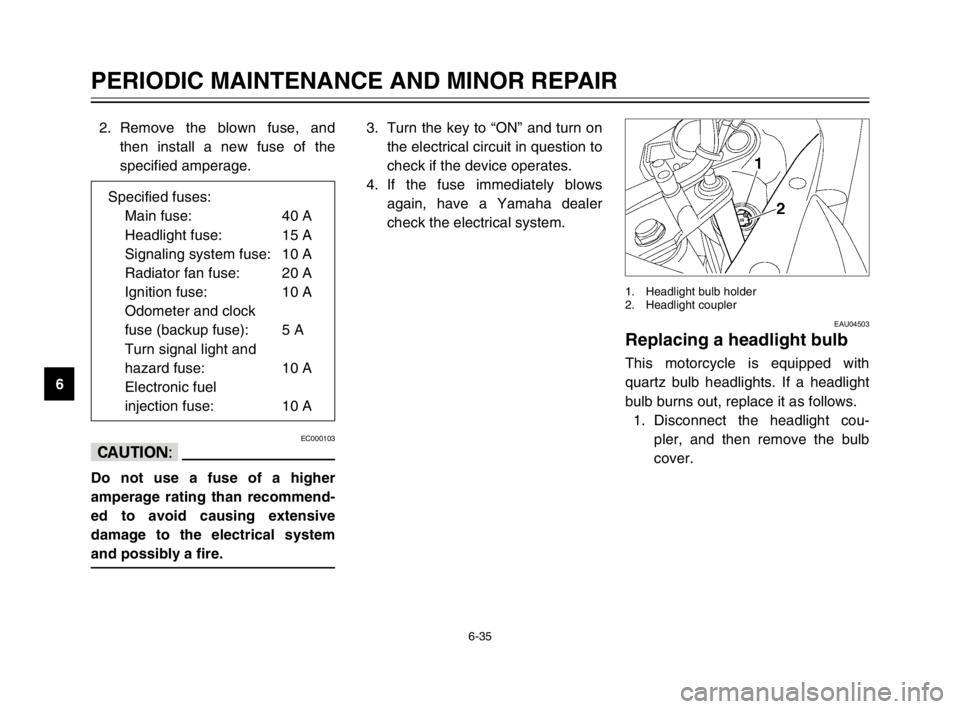
6-35
PERIODIC MAINTENANCE AND MINOR REPAIR
62. Remove the blown fuse, and
then install a new fuse of the
specified amperage.
EC000103
cC
Do not use a fuse of a higher
amperage rating than recommend-
ed to avoid causing extensive
damage to the electrical system
and possibly a fire.
EAU04503
Replacing a headlight bulbHeadlight bulb, replacingThis motorcycle is equipped with
quartz bulb headlights. If a headlight
bulb burns out, replace it as follows.
1. Disconnect the headlight cou-
pler, and then remove the bulb
cover.
1. Headlight bulb holder
2. Headlight coupler
3. Turn the key to “ON” and turn on
the electrical circuit in question to
check if the device operates.
4. If the fuse immediately blows
again, have a Yamaha dealer
check the electrical system. Specified fuses:
Main fuse: 40 A
Headlight fuse: 15 A
Signaling system fuse: 10 A
Radiator fan fuse: 20 A
Ignition fuse: 10 A
Odometer and clock
fuse (backup fuse): 5 A
Turn signal light and
hazard fuse: 10 A
Electronic fuel
injection fuse: 10 A
5PS-28199-E1 8/29/02 9:17 AM Page 80
Page 94 of 110

7
7-2
MOTORCYCLE CARE AND STORAGE
8Do not use any harsh chemical
products on plastic parts. Be
sure to avoid using cloths or
sponges which have been in
contact with strong or abra-
sive cleaning products, sol-
vent or thinner, fuel (gasoline),
rust removers or inhibitors,
brake fluid, antifreeze or elec-
trolyte.
8Do not use high-pressure
washers or steam-jet cleaners
since they cause water seep-
age and deterioration in the
following areas: seals (of
wheel and swingarm bearings,
fork and brakes), electric com-
ponents (couplers, connec-
tors, instruments, switches
and lights), breather hoses
and vents.8For motorcycles equipped
with a windshield: Do not use
strong cleaners or hard
sponges as they will cause
dulling or scratching. Some
cleaning compounds for plas-
tic may leave scratches on the
windshield. Test the product
on a small hidden part of the
windshield to make sure that it
does not leave any marks. If
the windshield is scratched,
use a quality plastic polishing
compound after washing.After normal use
Remove dirt with warm water, a mild
detergent, and a soft, clean sponge,
and then rinse thoroughly with clean
water. Use a toothbrush or bottle-
brush for hard-to-reach areas.
Stubborn dirt and insects will come
off more easily if the area is covered
with a wet cloth for a few minutes
before cleaning.
After riding in the rain, near the sea
or on salt-sprayed roads
Since sea salt or salt sprayed on
roads during winter are extremely
corrosive in combination with water,
carry out the following steps after
each ride in the rain, near the sea or
on salt-sprayed roads.
NOTE:
Salt sprayed on roads in the winter
may remain well into spring.
5PS-28199-E1 8/29/02 9:17 AM Page 93
Page 107 of 110
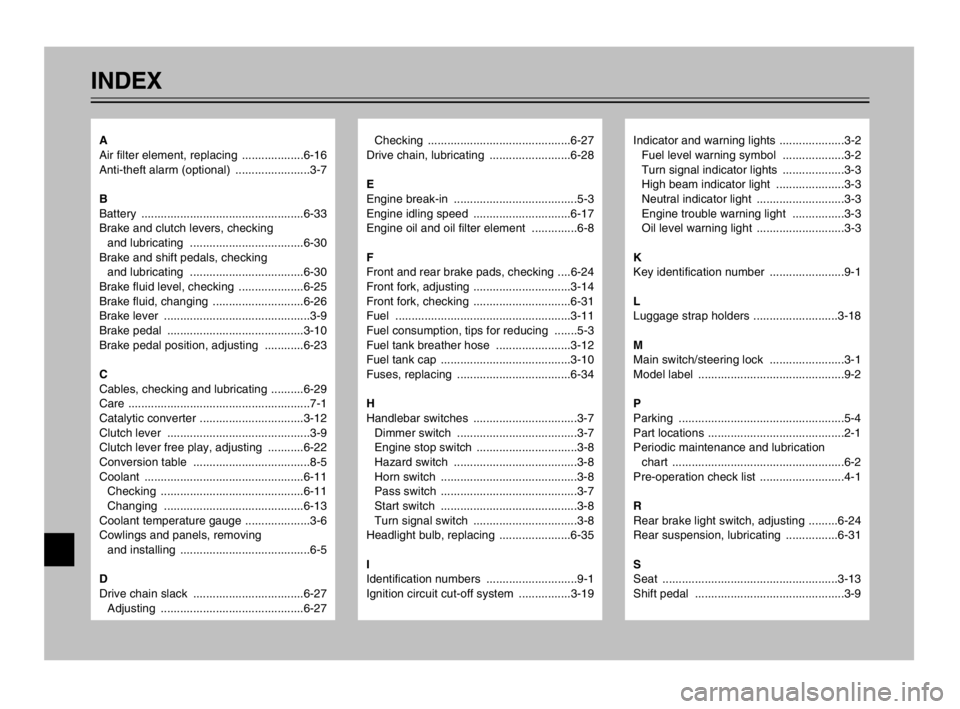
INDEX
Checking ............................................6-27
Drive chain, lubricating .........................6-28
E
Engine break-in ......................................5-3
Engine idling speed ..............................6-17
Engine oil and oil filter element ..............6-8
F
Front and rear brake pads, checking ....6-24
Front fork, adjusting ..............................3-14
Front fork, checking ..............................6-31
Fuel ......................................................3-11
Fuel consumption, tips for reducing .......5-3
Fuel tank breather hose .......................3-12
Fuel tank cap ........................................3-10
Fuses, replacing ...................................6-34
H
Handlebar switches ................................3-7
Dimmer switch .....................................3-7
Engine stop switch ...............................3-8
Hazard switch ......................................3-8
Horn switch ..........................................3-8
Pass switch ..........................................3-7
Start switch ..........................................3-8
Turn signal switch ................................3-8
Headlight bulb, replacing ......................6-35
I
Identification numbers ............................9-1
Ignition circuit cut-off system ................3-19Indicator and warning lights ....................3-2
Fuel level warning symbol ...................3-2
Turn signal indicator lights ...................3-3
High beam indicator light .....................3-3
Neutral indicator light ...........................3-3
Engine trouble warning light ................3-3
Oil level warning light ...........................3-3
K
Key identification number .......................9-1
L
Luggage strap holders ..........................3-18
M
Main switch/steering lock .......................3-1
Model label .............................................9-2
P
Parking ...................................................5-4
Part locations ..........................................2-1
Periodic maintenance and lubrication
chart .....................................................6-2
Pre-operation check list ..........................4-1
R
Rear brake light switch, adjusting .........6-24
Rear suspension, lubricating ................6-31
S
Seat ......................................................3-13
Shift pedal ..............................................3-9A
Air filter element, replacing ...................6-16
Anti-theft alarm (optional) .......................3-7
B
Battery ..................................................6-33
Brake and clutch levers, checking
and lubricating ...................................6-30
Brake and shift pedals, checking
and lubricating ...................................6-30
Brake fluid level, checking ....................6-25
Brake fluid, changing ............................6-26
Brake lever .............................................3-9
Brake pedal ..........................................3-10
Brake pedal position, adjusting ............6-23
C
Cables, checking and lubricating ..........6-29
Care ........................................................7-1
Catalytic converter ................................3-12
Clutch lever ............................................3-9
Clutch lever free play, adjusting ...........6-22
Conversion table ....................................8-5
Coolant .................................................6-11
Checking ............................................6-11
Changing ...........................................6-13
Coolant temperature gauge ....................3-6
Cowlings and panels, removing
and installing ........................................6-5
D
Drive chain slack ..................................6-27
Adjusting ............................................6-27
5PS-28199-E1 8/29/02 9:17 AM Page 106